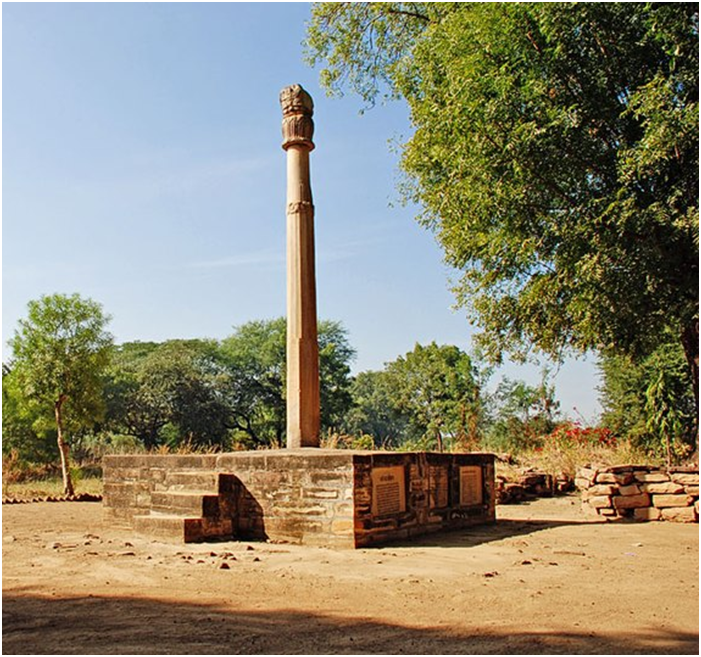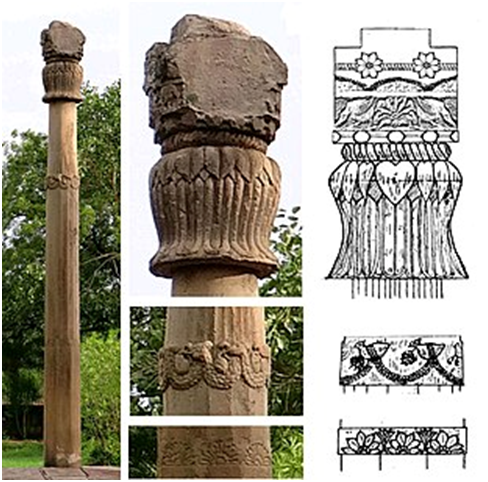Besnagar
Besnagar is situated east of the Betwa River, in the fork of the Betwa and Bes rivers, 9 km from Sanchi.
The town of Besnagar, 3 km from present-day Vidisha became an important trade centre in the 6th and 5th centuries BCE, under the Shungas, Nagas, Satavahanas, and Guptas, and was mentioned in the Pali scriptures.
The Emperor Ashoka was the governor of Vidisha during his father’s lifetime. His Buddhist Empress Vidisha Devi who was also his first wife, was brought up in Vidisha. It finds mention in Kalidasa’s Meghaduta.
Besnagar was known as Bhelsa during the medieval period.
Must read: “Dhamma ” of Ashoka
Heliodorus pillar

The Heliodorus pillar is a stone column that was erected around 113 BCE in central India in Besnagar near Vidisha, Madhya Pradesh.
The Heliodorus pillar site is located 11 kilometres from the Buddhist stupa of Sanchi, and 4 kilometres from the Hindu Udayagiri site.
The pillar was discovered by Alexander Cunningham in 1877.
The pillar is commonly named after Heliodorus, who was an ambassador of the Indo-Greek king Antialcidas from Taxila, and was sent to the Indian ruler Bhagabhadra.
The pillar was called the Garuda-standard by Heliodorus, referring to the deity Garuda.

A dedication written in Brahmi script was inscribed on the pillar, venerating Vāsudeva (krishna), the Deva deva the “God of Gods” and the Supreme Deity.
The pillar also glorifies the Indian ruler as “Bhagabhadra the savior”.
The pillar is a stambha which symbolizes joining earth, space and heaven, and is thought to connote the “cosmic axis” and express the cosmic totality of the Deity.
Two major archaeological excavations in the 20th-century have revealed the pillar to be a part of an ancient Vāsudeva temple site.
Aside from religious scriptures such as the Bhagavad Gita, the epigraphical inscriptions on the Heliodorus pillar and the Hathibada Ghosundi Inscriptions contain some of the earliest known writings of Vāsudeva-Krishna devotion and early Vaishnavism and are considered the first archeological evidence of its existence.
The pillar has been called one of the earliest surviving records of a foreign convert into Vaishnavism.
External link: https://en.wikipedia.org/wiki/Heliodorus_pillar
PRACTICE QUESTIONS
QUES . Consider the following pairs : UPSC PRELIMS 2023
Site : Well known for
1 . Besnagar : Shaivite cave shrine
2 . Bhaja : Buddhist cave shrine
3 . Sittanavasal : Jain cave shrine
How many of the above pairs are correctly matched?
(a) Only one
(b) Only two
(c) All three
(d) None
Ans (b) EXPLANATION: Besnagar is a Vaishnavite cave shrine.The Greek ambassador called Heliodorus set up a pillar in honour of Lord Vasudeva at Besnagar near Vidhisa in MP around the middle of the second century BC . Bhaja caves are Buddhist caves in Pune. They have apsidal vault roof chaitya halls. Sittanavasal is Jain cave shrine. Located in a tiny hamlet of Sittanavasal in the Pudukkottai district of Tamil Nadu, Sittanavasal Cave is a Jain complex of caves dating back to the 2nd century.It is believed that it was the settlement of certain monks from the eastern parts of India, who came here to preach lessons of Jainism and spread the positives of ascetic life. Later on, this site became a major Jain center.
